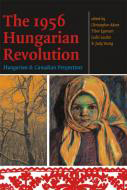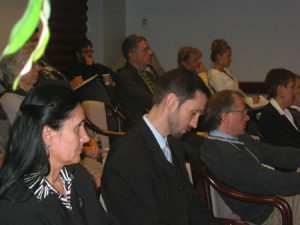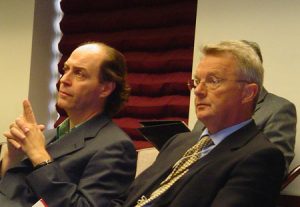Canadian and International Perspectives
New Canadian publication on 1956
September 19th, 2010
 The proceedings of the international conference which took place at the University of Ottawa in October 2006 to mark the 50th anniversary of the Hungarian Revolution have been published by the University of Ottawa Press. The conference was part of a series of activities in the fall of 2006 including concerts, films, exhibitions, and other commemorations undertaken in collaboration between national cultural agencies, universities, and community organizations. The Canada-Hungary Educational Foundation (set up in 2005 to create awareness for this anniversary and Canada’s generous response to the refugee exodus) participated in a number of these activities as reflected on many pages of this website, which was itself a 50th anniversary project. We are pleased to publish here a review by Ottawa writer and former CBC journalist Kevin Burns of this new collection of essays.
The proceedings of the international conference which took place at the University of Ottawa in October 2006 to mark the 50th anniversary of the Hungarian Revolution have been published by the University of Ottawa Press. The conference was part of a series of activities in the fall of 2006 including concerts, films, exhibitions, and other commemorations undertaken in collaboration between national cultural agencies, universities, and community organizations. The Canada-Hungary Educational Foundation (set up in 2005 to create awareness for this anniversary and Canada’s generous response to the refugee exodus) participated in a number of these activities as reflected on many pages of this website, which was itself a 50th anniversary project. We are pleased to publish here a review by Ottawa writer and former CBC journalist Kevin Burns of this new collection of essays.
The 1956 Hungarian Revolution. Hungarian and Canadian Perspectives will be officially launched at the University of Ottawa on November 2nd 2010. Details to follow.


Conference Highlights
An international scholarly conference took place from October 12th to October 14th , 2006 at the University of Ottawa’s Institute of Canadian Studies, with the cooperation of the Hungarian Studies Association of Canada, The National Arts Centre, the Embassy of Hungary, and the Canada-Hungary Educational Foundation. The conference was one of several major activities in the National Capital to mark the 50th anniversary of the 1956 uprising in Hungary and the arrival to Canada, a few months later, of nearly 40,000 Hungarian refugees. A call for papers went out to the international academic community in the fall of 2005 seeking papers on the following broadly defined themes:
- The 1956 revolution in Hungary in its historical, historiographical, and political contexts.
- An examination of the international context of the revolution and its aftermath.
- Canadian immigration and refugee policies in the 1950’s, the Canadian government’s response to the refugee crisis (comparisons to other countries), as well as the reception and integration process of the Hungarian arrivals.
- Contributions to Canadian life and society and comparative studies of post 1956 refugee and immigrant movements to Canada.
 The conference opened at the National Arts Centre on October 12th at 6 pm with an introductory lecture by Professor Mark Pittaway, associate dean academic of the Faculty of Arts at the Open University in the UK and well-known expert on Central Europe. The session, which was open to the public, was opened with remarks by University President Gilles Patry, His Excellency Dénes Tomaj, Ambassador of the Republic of Hungary, and Jayne Watson, Director of Communications on behalf of an indisposed Peter Herrndorf, President and Chief Executive Officer of the National Arts Centre.
The conference opened at the National Arts Centre on October 12th at 6 pm with an introductory lecture by Professor Mark Pittaway, associate dean academic of the Faculty of Arts at the Open University in the UK and well-known expert on Central Europe. The session, which was open to the public, was opened with remarks by University President Gilles Patry, His Excellency Dénes Tomaj, Ambassador of the Republic of Hungary, and Jayne Watson, Director of Communications on behalf of an indisposed Peter Herrndorf, President and Chief Executive Officer of the National Arts Centre.
Each half-day of the rest of the conference began with an introductory presentation by a special guest. On the first day, Janos M. Rainer and Csaba Békés, both from the 1956 Institute in Budapest, discussed their most recent research on the Revolution to set the stage for debate. The next day, Harold Troper of the University of Toronto and Nandor F. Dreisziger of the Royal Military College of Canada located the 1956-57 Hungarian immigration stream in its historical context, both from a Canadian and an international perspective. More than a dozen other papers were given by academic specialists from Canada, Hungary, the United States, Finland, and Poland. The conference ended with a round-table on cultural expressions of the 1956 Revolution in Canada.
 The conference opening at the National Arts Centre attracted a good crowd and there was a good core audience throughout. In addition to the academic presentations, conference participants were able to enjoy the exhibition “The Hungarian Exodus/ L’éxpérience hongroise au Canada”, on the immigration experience of the 1956 Hungarian refugees created by Susan Papp-Aykler of the Rakoczi Foundation and the Multicultural History Society of Ontario; a book display; the photo exhibit “New Lives/ Nouvelles vies” 50 portraits of Hungarian Canadians by V. Tony Hauser, one of Canada’s preeminent photographers, specially commissioned by and displayed in the foyer of the National Arts Centre; and a reading performance of “Csirkefej” [Chickenhead], a play by Hungarian playwright Gyorgy Spiro. For the conference programme and abstracts of the papers please click on the sidebar “Conference Highlights” above. At the same place there is also a link to the photo gallery; click on the link to see the pictures.
The conference opening at the National Arts Centre attracted a good crowd and there was a good core audience throughout. In addition to the academic presentations, conference participants were able to enjoy the exhibition “The Hungarian Exodus/ L’éxpérience hongroise au Canada”, on the immigration experience of the 1956 Hungarian refugees created by Susan Papp-Aykler of the Rakoczi Foundation and the Multicultural History Society of Ontario; a book display; the photo exhibit “New Lives/ Nouvelles vies” 50 portraits of Hungarian Canadians by V. Tony Hauser, one of Canada’s preeminent photographers, specially commissioned by and displayed in the foyer of the National Arts Centre; and a reading performance of “Csirkefej” [Chickenhead], a play by Hungarian playwright Gyorgy Spiro. For the conference programme and abstracts of the papers please click on the sidebar “Conference Highlights” above. At the same place there is also a link to the photo gallery; click on the link to see the pictures.
The organizers of the conference would like to express their gratitude to the Office of the University President, the Deans of Arts and Social Sciences of the University of Ottawa, the Social Sciences and Humanities Research Council and the Embassy of Hungary for their financial assistance. The conference organizers are working with the University of Ottawa Press on having a selection of the papers published in the near future.
